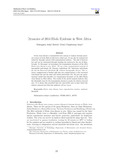| dc.contributor.author | Mutuguta, John W. | |
| dc.contributor.author | Rotich, T. | |
| dc.contributor.author | Chepkwony, I. | |
| dc.date.accessioned | 2019-09-30T11:35:49Z | |
| dc.date.available | 2019-09-30T11:35:49Z | |
| dc.date.issued | 2019 | |
| dc.identifier.issn | 2224-5804 | |
| dc.identifier.uri | http://hdl.handle.net/123456789/4348 | |
| dc.description | Vol.9, No.2, 2019 | en_US |
| dc.description.abstract | Ebola Virus disease 1s transmitted from human to human through physical contact of body fluid of infected or dead case It can also be transmitted indirectly through contact with contaminated surfaces. This risk is however low and can be minimised through cleaning the surfaces by the use of disinfectants. In this paper we investigate the transmission dynamics of the 2014 Ebola Virus disease 1n west Africa. We use a four compartmental network of Susceptible individuals (S), Exposed individuals (E), Infectious individuals (I) and the Removed individuals (91) without demographic factors. The re-moved compartment is further split into two compartments i.e the recovered individuals (R) and the dead and buried individuals (D). We give the mathematical model that describe the transmission dynamics of the 2014 Ebola virus disease in West Africa. The results of the model analysis indicate that the threshold value for the transmission dynamics equals the relative removal rate. It is shown that provided that the susceptible ratio is kept below the relative removal rate then the epidemic will not occur. | en_US |
| dc.language.iso | en | en_US |
| dc.publisher | Mathematical Theory and Modeling | en_US |
| dc.subject | Ebola; virus; disease; basic reproduction number; epidemic | en_US |
| dc.title | Dynamics of 2014 Ebola Epidemic in West Africa | en_US |
| dc.type | Article | en_US |

